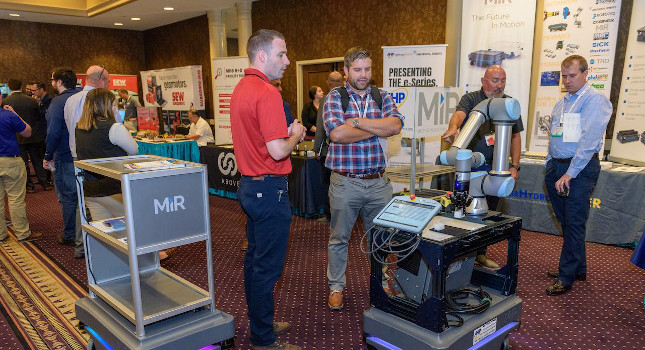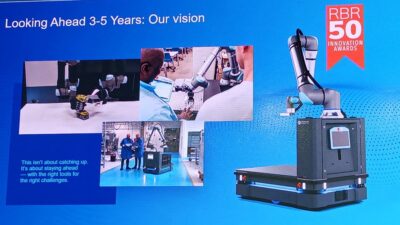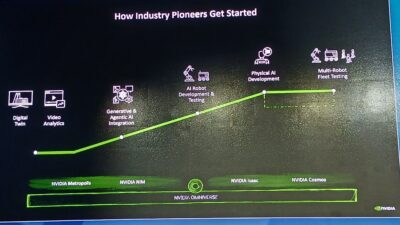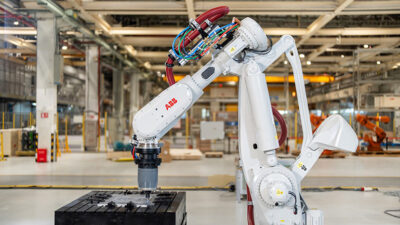System integrators should know an autonomous mobile robot's (AMR’s) programming and implementation capabilities make them attractive to end users.

Autonomous mobile robots (AMRs) are transforming traditional robot tasks through increased flexibility and diversified applications. AMRs are known for their unique ability to navigate in an uncontrolled environment with a higher level of understanding via sensors, blueprints, artificial intelligence (AI), 3-D or 2-D vision and more. Their perception allows these robots to re-route automatically when something is in their way. AMRs are innovative compared to a traditional automatic guided vehicle (AGV), which also is mobile, but uses wires or magnets to navigate a narrowly defined area from point A to point B.
New technologies
System integrators should know the AMR’s programming and implementation capabilities make them attractive to end users; most AMRs are at peak production when combined with another traditional robot system. However, it’s worth keeping in mind that AMR companies can go straight to market without an integrator. Providing solutions for using AMRs with traditional systems will give integrators the competitive edge.
Two examples of AMRs in action include the Honeywell General Merchandise Truck Unloader and the Mobile Industrial Robots Inc. MiR1000. The Truck Unloader is a flexible piece of machinery that can unload a variety of shapes, sizes or multiweighted products from a truck container using machine vision and sensors to decide how best to complete the task. The MiR1000 replaces the forklift, designed to withstand a payload of 1,000 kg (2,204 lb) and equipped with six laser scanners, 3-D cameras and an AI camera.
AMRs like these can allow companies to reduce the work in manufacturing and make more on time deliveries. Hybrid solutions incorporating traditional systems and AMRs working together are optimal. In examples like these, the truck-unloading AMR interfaces with a traditional fixed automated palletizer or conveyance system, leading the product further on its journey with complete automation. The robots enhance each other and increase efficiency, and can even maximize floor space, allowing for system integrators to work more machines into solutions; all of this can move product through processing at a faster pace.
It’s no longer enough to transport material from point A to point B; the most valuable AMRs incorporate a data-driven strategy. Traditional fulfillment centers use a person to pull inventory and bring it to a pick-and-pack station, which is done offline with no understanding of flow path optimization. Today’s AMRs are creating a digital understanding of end-to-end movement. AMRs are building aggregate data across the entire organization to create a common data architecture that understands the movement pattern of materials, how to improve and how to reconfigure and simulate optimizations.
System integrators can look for AMR incorporation in unloading trailers, fleet management in warehouses, conveyor systems, manufacturing work cells, hospitals, aerospace, semiconductors, automotive, logistics and more.
Safety and AMRs
The future of automation contains a fundamental shift: the reduction of barriers between the robot and its environment. Integrators should be cognizant of the Robotic Industries Association (RIA) R15.06: American National Standard for Industrial Robot Safety Standard, which addresses hazards in an industrial environment where the robot is bolted in place with fencing around the hazard zone.
Now, the industry is full of collaborative robots working in tandem with a person while the barriers are removed, and autonomous mobile robots are adding another layer of complexity to safety considerations.
“An AMR can approach a person without the person being aware of it,” said Carole Franklin, RIA Director of Standards Development. “We need to consider how to reduce the risk of a person being injured by an AMR or its payload.”
The RIA is introducing a new standard to address all aspects related to the safety of people around AMRs — R15.08 American National Standard for Industrial Mobile Robots and Robot Systems: Safety Requirements. The standard is designed to address these considerations for manufacturers, integrators and end users. The standard describes basic hazards associated with AMRs in an industrial environment, and provides requirements to eliminate, or reduce, the risks associated with these dangers.
“Should people and AMRs move freely within a shared space? How do the risks change if we move from a small, lightweight, low-payload AMR to a large, heavy and powerful robot? If additional equipment is added to the autonomous mobile platform, what requirements need to be stated to ensure that the resulting combined unit is safe?” Franklin said.
The committee, comprised of industry expert volunteers, is working through the formal revision and approval process, with the goal to have the standard ready for ballot by the end of 2019.
Industry outlook
In the first half of 2019, the North American robotics market is up 7.2%. From January to June, North American companies ordered 16,488 robots, valued at $869 million.
The largest driver of the year-to-date growth was an 83% increase in units ordered by automotive original equipment manufacturers (OEMs). Other industries that increased include semiconductor and electronics (12%), life sciences (8%) and food and consumer goods (3%).
In the second quarter alone, North American companies ordered 8,572 robots, valued at $446 million. This represents a growth of 19.2% in number of robots ordered, and a 0.6% boost in dollars compared to the same time period in 2018.
Certified Robot Integrator program
Another method of addressing safety is proper certification. RIA has developed an elite certification program, complete with an onsite audit, practical assessment of key personnel and safety training called the Certified Robot Integrator program. RIA developed this program at the request of end users of robots and integrators to set industry benchmarks. The RIA Certification is the only program of its kind; it is designed to give integrators a competitive advantage by positioning them as a trustworthy partner committed to producing high-quality robot systems.
Benefits of being a Certified Robot Integrator (CRI) include:
- Market the company’s expert status to distinguish from the competition
- Benchmark above industry best practices on technical and robot safety acumen
- Guarantee safety and quality of product to customers, per RIA certification standards
- Increase brand recognition based on trustworthiness and professionalism.
Currently, there are 39 integrator companies certified through RIA’s program. Integrators interested in the certification can download a self-scorecard from RIA’s website to determine if they meet the prerequisites.
Bob Doyle is vice president of Robotics Industries Association (RIA) and A3 Mexico, part of the Association for Advancing Automation (A3), a CFE Media content partner.
About Robotic Industries Association
RIA is a not-for-profit trade association dedicated to improving the regional, national and global competitiveness of the North American manufacturing and service sectors through promotion and enhancement of robotics and related automation. RIA is a part of the Association for Advancing Automation, the global advocate for the benefits of automating. The Association for Advancing Automation promotes automation technologies and ideas that transform the way business is done, and represents more than 1,200 automation manufacturers, component suppliers, system integrators, end users, research groups and consulting firms.
RIA Benefits for system integrators
Automation is a big investment for prospective customers. They need to choose a company with expertise to integrate their robotic systems. Executives, managers and engineers turn to RIA when they need to sharpen their knowledge.
When joining RIA as a system integrator, a company and all its employees demonstrate credibility, access continual learning and boost online visibility for increased customer acquisition. Aligning a business with RIA means aligning with the most trusted resource in automation.



